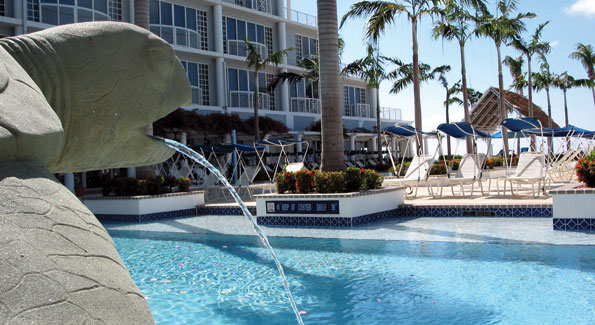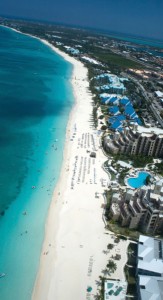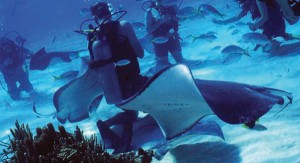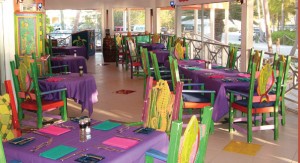If luxury is your goal, the Caribbean Club on Seven Mile Beach is the right place to stay. Completed in 2007, the spacious three-bedroom, 2,500-square-foot home-away-from-home residences are much more high-end condo than luxury hotel. Each unit comes equipped with track lighting, multiple wall-mounted flat screen TVs, open kitchens with granite counter tops and Kohler faucets, and spacious foyers with “I’m in Paradise” ocean and sunset views. If you’re spending time in one of the Caribbean’s richest nations, and if you’re going to pay brand name hotel rates (rooms start at $650 daily) you should get more space along with the amenities of a comfortable home. The fact that the fabulous Italian eatery Ristorante Luca is on the property doesn’t hurt either. Its chic but relaxed ambiance and extensive wine list attract discerning connoisseurs. Reservations are recommended.
Winds of Change
Besides luxe appeal, one of the more admirable traits about the Cayman Islands, which includes Grand Cayman, Little Cayman, and Cayman Brac, are efforts by the government and locals alike to blend high-end tourism with sustainability. One such proponent is Steve Broadbelt, owner of Ocean Frontiers and Compass Pointe Dive Resort.
“It has to be more than just changing light bulbs,” Broadbelt says as we sit on a sun-splashed wooden deck overlooking his boats. “We started with fuel for the dive boats; we use a locally produced 60 percent bio-diesel mix. Most other operators started doing the same after we switched.” Pointing to a row of jet skis, he says it soon “spread to water sport vehicles then cruise ship tenders.” He pauses and squints from the glare of the sun. “Being so close to the reef, we’re conscious of everything we use and how it affects the ocean.”
Energy is a big issue for Cayman residents. It’s expensive here, about 29 cents per kilowatt-hour compared to an average of nine cents in the continental United States. Less than one percent of the island nation’s energy comes from renewable sources, but the Cayman government is in the early phases of implementing a buy back program to encourage renewable energy generation.
The island nation’s first green movement protected coral reefs by placing moorings over them. The project has taken over 20 years. There are currently 300 locations that are drift dive accessible. As part of the “Dive 365” campaign, 65 more moorings are being added over the next three years so visitors and locals alike can “dive a different spot each day of the year.”
There are 25 different dive operators in the Cayman Islands. Each keeps a log to document dive trips – 6,000 visits per site is the maximum threshold a reef can accommodate before it becomes negatively impacted. Operators meet monthly to share notes and discuss safety, environmental issues, and marketing. They also calculate their carbon footprint and work with the Cayman Islands Department of Tourism and Sustainable Travel International to offset their environmental impact.
“Our business is the environment. Without it we’re out of luck,” Broadbelt says as we walk to one of his boats. “On a small island, everything is connected, everything makes an impact.”
I spend the rest of the day diving, witnessing this interconnectivity first-hand. Our dives include Old Wreck Head, Grouper Grotto and Pats Wall. Each offers a different wonderful terrain, from steep wall dives, a wreck, and shallow reefs.
5 to do CAYMANS!
1. Follow the Blue Dragon Trail
2. Dive Bloody Bay Wall
3. Sip a mudslide at Rum Pointe
4. Explore Rebecca Cave on Cayman Brac
5. Read the “Green Guide to the Cayman Islands”
Get to the Pointe
After diving, it was time for dinner and cocktails under a quintessential Caribbean sunset. One of the best places for all of the above is Rum Pointe in the Cayman Kai area. Rum Point Restaurant, nestled in the corner of a tree-lined beachfront paradise, has been a go-to spot for over 20 years. It specializes in seafood caught by local fisherman. If you’re concerned about ordering sustainable fish – which you should be! – pick up the National Trust’s Cayman Sea Sense Seafood Guide to avoid ordering over-fished or endangered commercial species.
Before settling in for dinner, I order a mudslide from the iconic yellow beachside Wreck Bar & Grill and let the dark rum settle into me as the sun dips slowly into a turquoise sea before exploding into hues of mandarin orange and purple.
Seven Mile Beach is the place to “see and be seen,” but Rum Pointe is the place to dig your toes in the sand, take a deep breath, and relax.
Big Escape on Little Cayman
“Paradise found” is all I can think as I disembark from an inter-island Cayman Airways flight from Grand Cayman. Little Cayman “airport” is smaller than my Adams Morgan studio apartment and just beyond the runway a “Brake For Iguanas” sign greets visitors at the entrance of the island’s lone road. I’m traveling light: a few T-shirts, a bathing suit, hat, sunglasses, and one pair of sandals.
Little Cayman is the least developed of the Cayman trio. With a resident population of less than 170, most of this small stretch of land remains uninhabited. Only 10 miles long and a mile wide, it offers that rare combination of sun-blessed solitude, beautiful beaches and miles of untouched tropical wilderness.
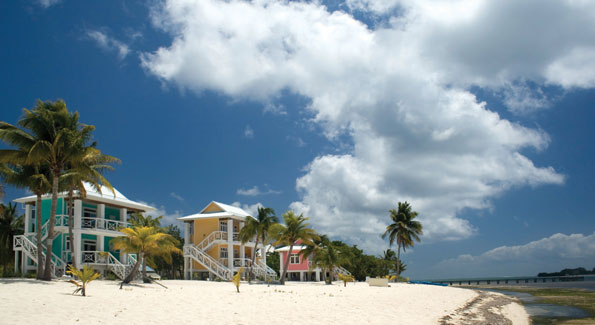
The colorful bungalows of Southern Cross Club on Little Cayman overlooking Owen Island in the distance.
My destination is the Southern Cross Club, Fish & Dive Resort, the island’s oldest original resort. It’s known for its colorful collection of bungalows and laid-back “barefoot luxury” style. By the end of the first day, my phone and shoes are off, the bartender knows my name, and there are enough stars in the sky to make Captain Kirk blush. I’ve also learned to stop telling people I’m a travel writer.
“Tell your readers the sharks are big and the mosquitoes even bigger,” says a bespectacled San Francisco lawyer, who, along with her husband, have been coming here for 15 years. We are conversing over a Mahi Mahi dinner at Pirates Point Resort – a homespun restaurant and resort founded by Gladys Howard, an eccentric Texan with a flair for art, sustainability, gourmet food, and keeping things aw-schucks-simple. In 2003, she was awarded the Queen’s “Badge of Honor” by Prince Edward during the Cayman Islands Quincentennial for her volunteer work in environmental conservation. She’s been a pioneer here since the ’60s when she turned a sleepy fishing camp into her own personal paradise.
As we finish dinner, the San Francisco couple badger me more, “… And tell your readers that hurricanes Gustav and Paloma flattened the island. We’d like to keep it to ourselves.”
The hurricanes didn’t flatten the island, but evidence of their destructive power is evident in the form of still-boarded-up windows and an occasional roof shingle on the beach. But Little Caymanites are resilient. Case in point: American ex-pat Peter L. Hillenbrand, owner of the Southern Cross Club. I chose to visit Southern Cross because Hillenbrand has been a leader in sustainable tourism for years.
I was impressed with the overall service of the resort. Bungalows run $1,390 for five nights, double occupancy in summer and $1,645 for the same in winter. That includes three meals a day and free use of the pool, bikes, kayaks, and snorkel equipment. The resort has an honor pay system at the bar (during the day), friendly service, and top-notch fishing and diving operations.
My second day starts with a tour of the island. Hillenbrand is keen to talk green. “We’re trying to be as sustainable as possible,” he says as we hop into a weathered Suzuki Samurai. “Each bungalow is fully insulated, we use all biodegradable chemicals, and our water is heated by solar panel. We want to go completely solar, but the energy company hasn’t installed meters that calculate energy going back into the grid – they think it will decrease their profitability.”
As we slow down, Hillenbrand points out the 203-acre Booby Pond Nature Reserve. “This is home to the largest known breeding colony of the Red Footed Booby (5,000 pairs) in the Caribbean, a breeding colony of Magnificent Frigate Birds, and a large heron colony.”
Our discussion soon turns to water usage. “The resort tries to keep average daily water use at 20 gallons per guest; we keep track so guests can ask about their use and self-police.” The car comes to a bumpy halt for an up close and personal encounter with the island’s unofficial mascot – the Little Cayman Rock iguana. There’s nothing “little” about them. Males can grow to a nose-to-tail length of five feet and weigh as much as 30 pounds. “There’s a population of about 2,000 of these guys, they’re indigenous,” he says fondly. I get back in the car quickly.
Back on the weathered one-lane road, Hillenbrand points to a mansion hidden behind a row of trees, “See that house, the guy who started Pizza Hut lives there. He flies in pizza from Grand Cayman sometimes; not very sustainable,” he says with a laugh. “Oh, Burgess Meredith lived on the island too, in the ’70s.” I restrain myself from asking if he lived on “Rocky” pointe.
Our final destination is the Little Cayman Research Center, which serves as a lab for the Central Caribbean Marine Institute (CCMI). Hillenbrand is chairman of CCMI and helps maintain the facility. It offers visiting scholars and students flowing sea water tanks, laboratories, a classroom, private and dormitory-style rooms, a sustainable off-the-grid bathhouse, and easy access to shallow reefs as well as the Caribbean’s best vertical drop off, Bloody Bay Wall in the Bloody Bay Marine Park.
Bloody Bay Wall begins at a shallow depth of 22 to 30 feet and falls away to the abyssal depth of 1,000 feet. It’s so vertical that divers talk of feeling “a sky dive sensation” as they hang in space over the ledge. There are a number of world-class dives along the wall. The Green Guide to the Cayman Islands, a pamphlet published by CCMI, meanwhile should be in the hands of every visitor to the Islands. It will help guide you through a green Cayman vacation.
“Sometimes I wonder if we are lucky or unlucky on Little Cayman,” Hillenbrand confides in a pensive moment. I’m surprised to hear him say that and ask why. He replies, “Because the island could use better infrastructure, I mean, the bank is only open on Wednesdays. We only have two small swimming beaches and the airport is tiny, so we don’t generate interest from larger developers.” I ask what he envisions for Little Cayman in the next five to 10 years. “I would love to see it all electric; totally off the grid, golf carts, solar powered, the whole thing.”
I spend the final morning sea kayaking around Owen Island – a small spit of land located offshore from the Southern Cross Club. I listen to the waves slap lazily against the hollow plastic hull of my kayak and feel the light Caribbean breeze whistle through my ears. Hillenbrand might want to take Little Cayman off the grid, but Little Cayman has been taking visitors off of it ever since they started arriving.

